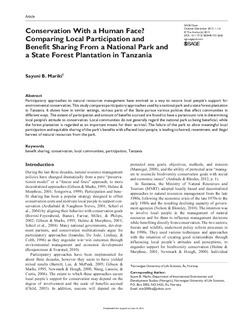| dc.contributor.author | Mariki, Sayuni | |
| dc.date.accessioned | 2015-06-19T08:45:40Z | |
| dc.date.accessioned | 2015-08-17T07:22:15Z | |
| dc.date.available | 2015-06-19T08:45:40Z | |
| dc.date.available | 2015-08-17T07:22:15Z | |
| dc.date.issued | 2014 | |
| dc.identifier.citation | Sage Open 2014, 3(4) | |
| dc.identifier.issn | 2158-2440 | |
| dc.identifier.uri | http://hdl.handle.net/11250/297100 | |
| dc.description | - | |
| dc.description.abstract | Participatory approaches to natural resources management have evolved as a way to secure local people’s support for
environmental conservation. This study compares participatory approaches used by a national park and a state forest plantation
in Tanzania. It shows how in similar settings, various parts of the State pursue various policies that affect communities in
different ways. The extent of participation and amount of benefits accrued are found to have a paramount role in determining
local people’s attitude to conservation. Local communities do not generally regard the national park as being beneficial,
while
the forest plantation is regarded as an important means for their survival. The failure of the park to allow meaningful local
participation and equitable sharing of the park's benefits with affected local people, is leading to hatred, resentment, and
illegal
harvest of natural resources from the park. | |
| dc.language.iso | eng | |
| dc.relation.uri | http://sgo.sagepub.com/content/3/4/2158244013512665.short | |
| dc.rights | Navngivelse 3.0 Norge | |
| dc.rights.uri | http://creativecommons.org/licenses/by/3.0/no/ | |
| dc.title | Conservation with a human face? Comparing local participation and benefit sharing from a national park and a state forest plantation in Tanzania | |
| dc.type | Journal article | |
| dc.type | Peer reviewed | |
| dc.date.updated | 2015-06-19T08:45:40Z | |
| dc.identifier.doi | 10.1177/2158244013512665 | |
| dc.identifier.cristin | 1072103 | |

